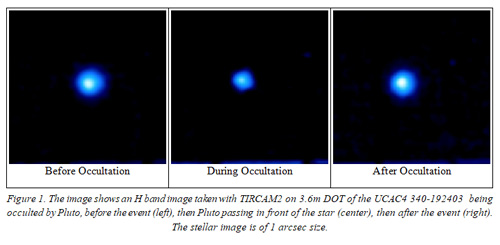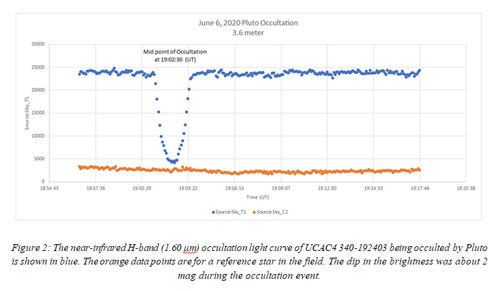 Scientists from Aryabhatta Research Institute of Observational Sciences (ARIES) an autonomous institute of the Department of Science & Technology in collaboration with an international team including groups within India (Physical Research Laboratory (PRL), Indian Institute of Space Science and Technology (IIST), Indian Institute of Astrophysics (IIA), Akashmitra Mandal) followed the occultation of a bright star UCAC4 340-192403 by the dwarf planet Pluto on June 6, 2020.
Scientists from Aryabhatta Research Institute of Observational Sciences (ARIES) an autonomous institute of the Department of Science & Technology in collaboration with an international team including groups within India (Physical Research Laboratory (PRL), Indian Institute of Space Science and Technology (IIST), Indian Institute of Astrophysics (IIA), Akashmitra Mandal) followed the occultation of a bright star UCAC4 340-192403 by the dwarf planet Pluto on June 6, 2020.According to the scientists of ARIES, the observations obtained will enable a detailed investigation of Pluto’s atmosphere as the initial processed occultation light curves (stellar occultation occurs when the light from a star is blocked by an intervening body (such as a planet, moon, ring, or asteroid) from reaching an observer) from the present observation are of the good signal-to-noise ratio.
Visual scrutiny of the observed occultation light curves clearly revealed signatures of Pluto’s atmosphere as smoothly changing ingress and egress slopes. These detections will be of paramount importance to measure Pluto’s atmospheric pressure in 2020.
 After the last stellar occultation on 2016 July 19, dwarf planet, Pluto, has occulted a bright star UCAC4 340-192403 on 2020 June 6 with the predicted path crossing northern India with a duration of around 136 seconds at Devasthal and Hanle, respectively. An international team led by Prof. N. M. Ashok (PRL) and Prof. Bruno Sicardy (Lucky star project, Observatorie de Paris, France) in collaboration with groups within India (ARIES, PRL, IIST, IIA, Akashmitra Mandal) followed this very rare event. Team members, Dr. Saurabh from ARIES and Dr. BC Bhatt from IIA, led the observations at Devasthal and Hanle, respectively.
After the last stellar occultation on 2016 July 19, dwarf planet, Pluto, has occulted a bright star UCAC4 340-192403 on 2020 June 6 with the predicted path crossing northern India with a duration of around 136 seconds at Devasthal and Hanle, respectively. An international team led by Prof. N. M. Ashok (PRL) and Prof. Bruno Sicardy (Lucky star project, Observatorie de Paris, France) in collaboration with groups within India (ARIES, PRL, IIST, IIA, Akashmitra Mandal) followed this very rare event. Team members, Dr. Saurabh from ARIES and Dr. BC Bhatt from IIA, led the observations at Devasthal and Hanle, respectively.The event was successfully recorded in the H-band using TIFR Infrared Camera (TIRCAM2) mounted on the 3.6m Devasthal Optical Telescope, while the optical light curve in the I-band observed with the 1.3m Devasthal Fast Optical Telescope. Attempts with the Himalayan Chandra Telescope at Hanle were not successful due to thick cloud coverage.
Stellar occultations by Pluto observed between 1988 and 2016 showed that Pluto’s atmospheric pressure increased by a spectacular factor of three, due to seasonal effects. The sublimation by solar rays of a vast nitrogen glacier (SpunikPlanitia) on Pluto expanded this atmosphere for nearly thirty years. Current climatic models predict that this expansion should now stop, leading to a gradual decline of Pluto’s atmosphere that could be tested with this observation. This observation is particularly important since occultations by Pluto are getting rarer, as the dwarf planet now moves away from the Milky Way, as seen from Earth.
For more details, Dr. Saurabh (ARIES) (saurabh[at]aries[dot]res[dot]in), Prof. N M Ashok (PRL) (ashoknagarhalli[at]gmail[dot]com), Prof. AnandmayeeTej (IIST) (anandmayee[dot]tej[at]gmail[dot]com) can be contacted.






























